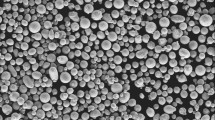The 316L stainless steel meets all health, strength, and quality standards and is an irreplaceable material in the manufacture of medical equipment. The study focused on the 316L austenitic stainless steel, manufactured with the conventional technique in accordance with ASTM A276/A276M–17 Condition A (samples rolled and annealed at 1050°C with water cooling) and with the selective laser melting (SLM) technique (as-printed starting samples). Unlike conventional manufacturing techniques, SLM offers significantly greater design freedom. An AxioMat 200M optical microscope was employed to analyze the microstructure in different lighting modes, and Kalling’s and Marble’s reagents were used to reveal the structure. The 316L steel produced conventionally mainly consisted of austenite (microhardness of 239 kg/mm2), and substantial cross- sectional grain heterogeneity was established in the test sample. Twins and an atypical multidirectionally oriented dense acicular structure in the area of individual grains (microhardness of 260‒286 kg/mm2) and a unidirectional loose structure (microhardness of 317‒328 kg/mm2) were observed. The microstructure of the 316L steel produced with the SLM technique mainly consisted of austenite (microhardness of 268 kg/mm2). The boundaries of the primary austenite grains were revealed with Marble’s reagent, and arc-shaped structures of the melt bath were established. Kalling’s reagent revealed an atypical multidirectionally oriented intragranular substructure, located primarily between the tops of next-layer tracks in areas where previous-layer tracks overlapped (longitudinal microhardness of 239–251 kg/mm2 and cross-sectional microhardness of 286–317 kg/mm2). Elongated columnar grains were found using differential interference contrast microscopy. The average ultimate strength of the steel samples produced with the conventional technique was higher than that of the samples produced with SLM by 4.63%, yield strength by 1.53%, relative elongation by 8.27%, and relative contraction by 18.36%. The lower level of properties and greater spread of their values for the SLM steel were due to the presence of elongated grains and anisotropy relative to the buildup direction. The actual level of properties shown by the SLM steel in the starting state meets the regulatory requirements.








Similar content being viewed by others
References
S.V. Adzhamskyy, G.A. Kononenko, and R.V. Podolskyy, “Comparative studies of the structure and properties of cast AISI 316L and produced with SLM,” in: Proc. Int. Conf. University Science–2021 (2021), pp. 62–64.
J.-P. Kruth, M.-C. Leu, and T. Nakagawa, “Progress in additive manufacturing and rapid prototyping,” CIRP Ann. Manuf. Technol., 47, No. 2, 525–540 (1998).
A. Röttger, J. Boes, W. Theisen, M. Thiele, C. Esen, A. Edelmann, and R. Hellmann, “Microstructure and mechanical properties of 316L austenitic stainless steel processed by different SLM devices,” Int. J. Adv. Manuf. Technol., 108, 769–783 (2020), https://doi.org/10.1007/s00170-020-05371-1.
D. Brackett, I. Ashcroft, and R. Hague, “Topology optimization for additive manufacturing,” in: Proc. SFF Symp. (2011), pp. 348–362.
R. Casati and L.M. Vedani, “Microstructure and fracture behavior of 316L austenitic stainless steel produced by selective laser melting,” J. Mater. Sci. Technol., 32, Issue 8, 738–744 (2016).
M. Tang, P.C. Pistorius, and J.L. Beuth, “Prediction of lack-of-fusion porosity for powder bed fusion,” Addit. Manuf., 14, 39–48 (2017).
S.V. Adzhamskyy, G.A. Kononenko, and R.V. Podolskyy, “Effect of SLM parameters on the formation of boundaries in parts produced from Inconel 718 creep-resistant nickel alloy,” Kosm. Nauka Tekhnol., 27, No. 6(133), 105–114 (2021), https://doi.org/10.15407/knit2021.06.105.
S.V. Adzhamskyy, H.A. Kononenko, and R.V. Podolskyi, “Analysis of structure after heat treatment of Inconel 718 heat-resistant alloys made by SLM-technology,” Metallofiz. Noveish. Tekhnol., 43, No. 7, 909–924 (2021), https://doi.org/10.15407/mfint.43.07.0909.
A. P. Gulyaev, Metallurgical Science [in Russian], Metallurgiya, Moscow (1977), p. 646.
Yu. M. Lakhtin, Metallurgical Science and Heat Treatment of Metals: Handbook [in Russian], Metallurgiya, Moscow (1976), p. 407.
Yu.I. Kokovikhin, Steel Wire Production Technology: University Handbook [in Russian], Inst. Syst. Issled. Obraz., Kyiv (1995), p. 608.
E. Houdremont, Special Steels [Russian translation], Metallurgiya, Moscow (1966).
O.I. Babachenko, G.A. Kononenko, O.V. Roslik, K.M. Maistrenko, and R.V. Podolskyy, Development of Steels for Railway Metal Products [in Ukrainian], Dominanta-Print, Dnipro (2021), p. 298.
T. Kurzynowski, K. Gruber, W. Stopyra, B. Kuźnicka, and E. Chlebus, “Correlation between process parameters, microstructure and properties of 316L stainless steel processed by selective laser melting,” Mater. Sci. Eng. A, 718, 64–73 (2018), https://doi.org/10.1016/j.msea.2018.01.103.
L. Hitzler, J. Hirsch, B. Heine, M. Merkel, W. Hall, and A. Ochsner, “On the anisotropic mechanical properties of selective laser-melted stainless steel,” Materials, 10, 1136 (2017), https://doi.org/10.3390/ma10101136.
M. Garibaldi, I. Ashcroft, M. Simonelli, and R. Hague, “Metallurgy of high-silicon steel parts produced using selective laser melting,” Acta Mater., 110, 207–216 (2016), https://doi.org/10.1016/j.actamat.2016.03.037.
M.S.I.N. Kamariah, W.S.W. Harun, N.Z. Khalil, F. Ahmad, M.H. Ismail, and S. Sharif, “Effect of heat treatment on mechanical properties and microstructure of selective laser melting 316L stainless steel,” IOP Conf. Ser. Mater. Sci. Eng., 257, Id. 012021 (2017), https://doi.org/10.1088/1757-899X/257/1/012021.
W. Shifeng, L. Shuai, W. Qingsong, C. Yan, Z. Sheng, and S. Yusheng, “Effect of molten pool boundaries on the mechanical properties of selective laser melting parts,” J. Mater. Proc. Technol., 214, No. 11, 2660–2667 (2014), https://doi.org/10.1016/j.jmatprotec.2014.06.002.
S. Adjamskiy, G. Kononenko, R. Podolskyi, and S. Baduk, “Studying the influence of orientation and layer thickness on the physico-mechanical properties of Co–Cr–Mo alloy manufactured by the SLM method,” Sci. Innov., 18, No. 5, 85–94 (2022), https://doi.org/10.15407/scine18.05.085.
Author information
Authors and Affiliations
Corresponding author
Additional information
Translated from Poroshkova Metallurgiya, Vol. 62, Nos. 7–8 (552), pp. 68–80, 2023.
Rights and permissions
Springer Nature or its licensor (e.g. a society or other partner) holds exclusive rights to this article under a publishing agreement with the author(s) or other rightsholder(s); author self-archiving of the accepted manuscript version of this article is solely governed by the terms of such publishing agreement and applicable law.
About this article
Cite this article
Adjamsky, S.V., Kononenko, G.A., Podolskyi, R.V. et al. Mechanical Properties and Microstructure of the 316L Steel Produced by Different Methods. Powder Metall Met Ceram 62, 436–444 (2023). https://doi.org/10.1007/s11106-024-00405-9
Received:
Published:
Issue Date:
DOI: https://doi.org/10.1007/s11106-024-00405-9




